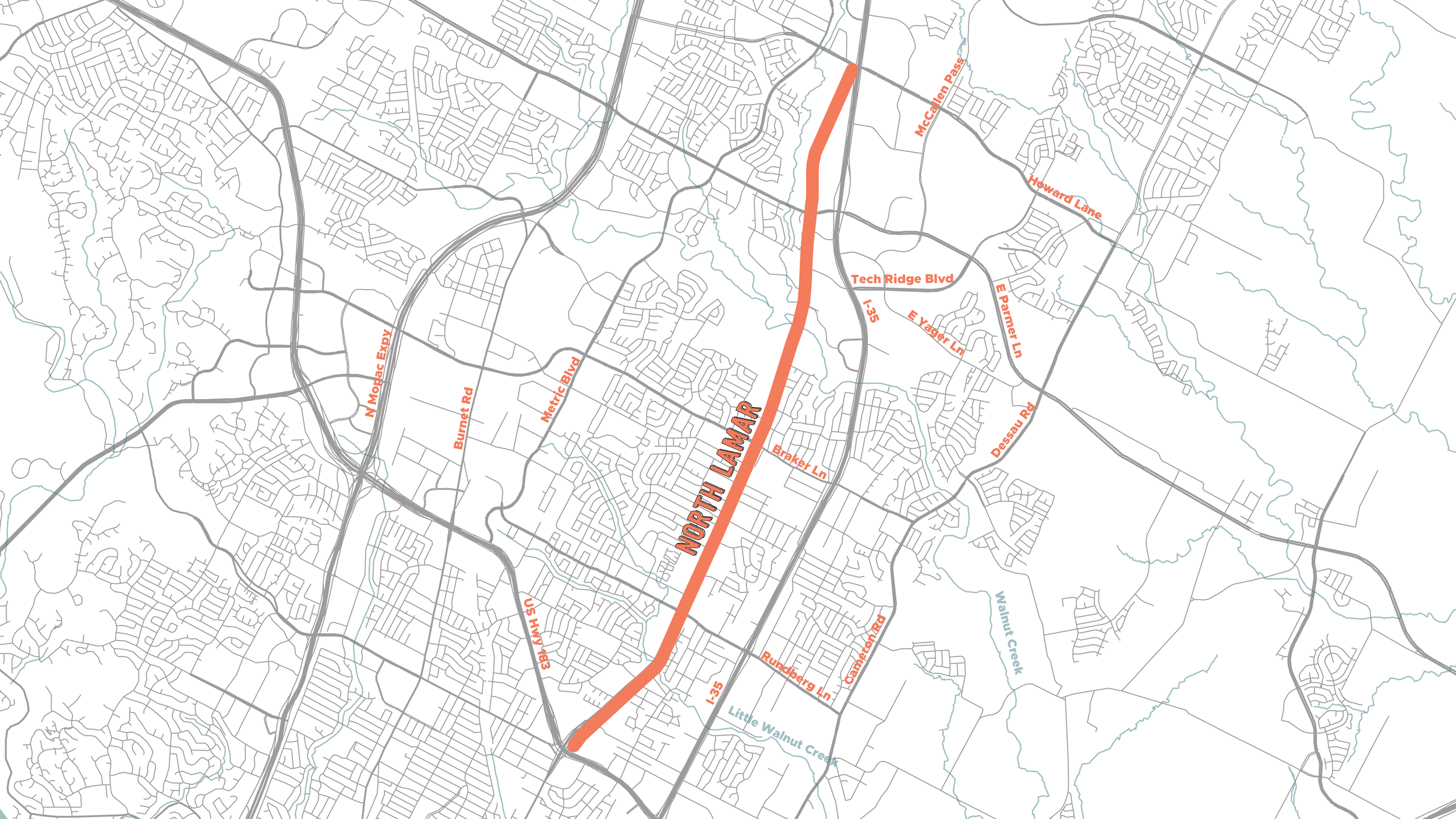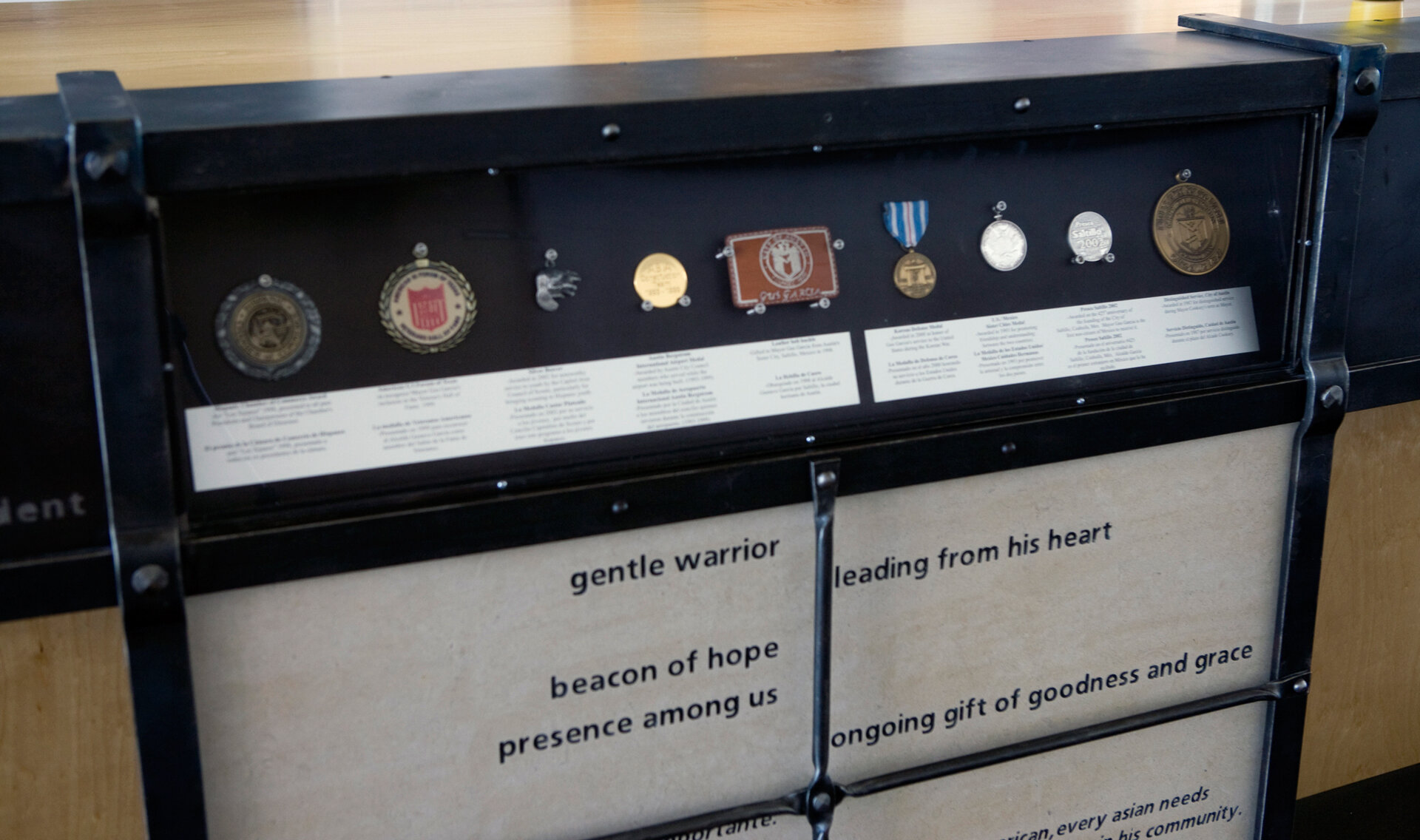North Lamar Boulevard
North Lamar Boulevard runs through some of the most culturally diverse communities in the city.
It is a busy roadway that connects commuters to the heart of the city. Many drive North Lamar Blvd, but the road is also frequented by pedestrians, and transit-users, although some segments lack adequate pedestrian and bicyclist infrastructure. North Lamar Blvd is a major transit route and is home to the North Lamar Transit Center, which serves as a hub to several popular bus routes.
—————————————————————————————————-
North Lamar Boulevard atraviesa algunas de las comunidades con mayor diversidad cultural de la ciudad. Es una carretera muy transitada que conecta a los viajeros con el corazón de la ciudad. Muchos conducen por North Lamar Blvd, pero la carretera también es frecuentada por peatones, ciclistas y usuarios del transporte público, aunque algunos segmentos carecen de una infraestructura adecuada para peatones y ciclistas. North Lamar Blvd es una importante ruta de tránsito y es la sede del Centro de Tránsito de North Lamar, que sirve como un centro de varias líneas de autobuses.
Celebrating the 2015 Moon Festival at Chinatown Center .Source: chinatownaustin.com
History
Land Acknowledgement
The settlement of the North Austin Civic Association (NACA) area by Anglo farmers from the Zimmerman cabin built in 1854 at 9019 Parkfield, to the town of Fiskville, formerly centered near Payton Gin and North Lamar. But this area’s history is far deeper and richer than that. Our civic association acknowledges that the land boundaries of NACA are original territory of a number of indigenous people—specifically the Numunuu, also known as the Comanche Nation, and the Tonkawa Tribe. We honor and thank the indigenous peoples connected to this territory where we live and gather. NACA will work towards decolonizing our practices, and make our civic association an inclusive space for all.
En el pasado, este boletín describió el asentamiento del área de NACA por parte de agricultores anglos como la casa Zimmerman construida en 1854 en 9019 Parkfield, y el pueblo de Fiskville, que había estado cerca de Payton Gin y North Lamar. Pero la historia de esta área es mucho más profunda y rica que eso. Nuestra asociación cívica quisiera reconocer que los límites terrestres de NACA son territorio original de varios pueblos indígenas, específicamente los Numunuu, también conocidos como la nación Comanche, y la tribu Tonkawa. Honramos y agradecemos los pueblos indígenas conectados a este territorio donde vivimos y nos reunimos. NACA trabajará para descolonizar nuestras prácticas y hacer de nuestra asociación cívica un espacio inclusivo para todos.
Source: NACA newsletter, written by Isa Boonto-Zarifis
What is now North Lamar Boulevard was once part of State Highway 2, which was constructed in the early 1900s to connect Laredo, San Antonio, Austin, Waco, Fort Worth and Oklahoma. Over the years, this corridor has held multiple titles, but ultimately it was named for Republic of Texas President (1838-41) Mirabeau Buonaparte Lamar.
Fiskville railroad stop in 1966, located at North Lamar and Payton Gin Road. It was the first railroad stop north of Austin. Source: PICA 17937, Austin History Center, Austin Public Library
The area now know as North Lamar was once a thriving community of freed African-American slaves. The founding members of that community were Rubin and Elizabeth Hancock who, after emancipation from Judge John Hancock, purchased land, started a farm and a community, and raised their five children.
Learn more about the Rubin Hancock Farmstead at the Texas Beyond History website. Source: Texas Beyond History, Texas Archeological Research Laboratory, University of Texas at Austin
A few remaining structures exist of the original farm houses that dotted the area, including the Old Zimmerman Home that was originally built in 1854 and is still located at 9019 Parkfield Road.
Source: Civic Arts
In the 1900s, North Lamar Boulevard hosted an eclectic entertainment scene. From the old Coxville Zoo to the Chief Drive-In movie theatre, there were plenty of attractions along North Lamar Blvd to keep Austinites entertained at the turn of the century. There were also iconic music venues along this roadway.
Inside the Owl Club in 1940. Source: Copperfield/Northeast Austin History Project
The Skyline Club, which opened in 1948, was a very large and well-known landmark. The club hosted performances by famous musicians like Elvis Presley, Hank Williams, and Johnny Horton. The Skyline Club entertained residents of the north Austin area until it closed in 1989.
Hank Thompson at the Skyline Club. Source: Ger J. Rijff
Life on the Corridor
When Navarro High School (formally Lanier High School) was first built circa 1970, the area the North Lamar landscape was very different.
Today, schools and families define the center of community life along North Lamar.
Hear Juan, now a freshman in high school, talk about the experience of growing up and going to school in the area.
Source: Navarro High School Principal Steve Covin
Resource: See the original City Council meeting minutes where Austin-Georgetown Road was renamed to Lamar Boulevard
“
[The schools here] they have English classes. They have computer classes (that I run away from) cooking classes - they've got them in daytime, they've got them in nighttime. We have daycare for them….. they have resources there for anything you need. And if, they can't help you. They will tell you where you could go.
Manuela Cisneros
Rundberg Fall Festival at Barrington Elementary School is run by volunteers like Manuela Cisneros, who work to promote opportunities and resources for the neighborhood, 2018. Source: READ Alliance
Listen to North Lamar resident Aida Cerda-Prazak talk the things you could never preserve in time capsule - music, dance, food, languages - that make the North Lamar area so special, so memorable, and so much the place that people call home.
Danza Azteca Guadalupana at Gus Garcia Recreation Center at a community gathering that featured health resources and local talent. Source: READ Alliance
The North Austin Community Garden designed by Artists Lucy Begg and Robert Gay of Thoughtbarn is at the City of Austin/YMCA North Austin Community Recreation Facility. The artists worked extensively with the local community, through workshops and public events, to develop the design of the garden and to install the garden beds, tool shed, and fencing. The Garden Leadership Group is now led by community volunteers who run and manage this sustainable garden that yields fresh produce for the community.
Information provided through Public Art Archive and here are community members tending to the garden. Source: North Austin Community Garden
Today, the North Lamar area of Austin is an area with one of the largest densities of children and lowest densities of available open space. Community groups like Georgian Acres Neighborhood Association work together with schools like Barrington Elementary School to ensure that schoolyards can also serve as community gathering spaces.
Barrington Elementary Garden Festival, March 2018. Source: READ Alliance
“Porque hay muchas culturas muy diferentes. Hay hondureños, guatemaltecos, mexicanos y americanos. Y la comida también varea mucho.”
———————————
—————————————————————————-
“Because there are many very different cultures. There are Hondurans, Guatemalans, Mexicans, and Americans. And the food also varies a lot.”
Listen to Austin Voices Family Resources Director Jose Carrasco talk about how that diversity is the heart of the area’s vitality.
One of the greatest cultural assets along North Lamar are the large number of international restaurants started and run by people who call the area home.
Source: Civic Arts
Listen to Hanna Huang, executive director of the Austin Asian American Film Festival, share about her work and the importance of recognizing Asian-American stories today.
Chinatown Center at the corner of North Lamar and Kramer opened in 2006. Source: Gary K./Yelp
Listen to owner Živojin “Z” Zekic of Balkan Cafe and Grill talk about how he and his family moved to Austin and started the business after being displaced by the Balkan Wars. His inspiration came from his father as he watched him open his business soon after arriving to the United States in the 1990s.
Source: Civic Arts
Listen to long-time community member Ann Teich explain how the physical environment supported the needs of many newly arriving to the United States. Accessibility has always been one of the key characteristics of North Lamar / Rundberg area. The area attracts many refugees who needed public transportation options to get to work.
Artbox by artist Bydee , in front of the Little Walnut Creek Library. Source: Austin Transportation
The North Lamar community comes together in many ways. Difficult times brought about the COVID pandemic, have been met with collaborative efforts and weekly food drives run by Austin Voices for Education and Youth, Gus Garcia Recreation Center, and the North Austin YMCA.
PTA and community volunteer Manuela Cisneros Source: Austin Voices
“Tu cultura es muy importante. I believe that if we are going to have a good city, every Hispanic, every African American, every Asian needs to feel like a first class citizen in his community. That feeling goes down to the last bone in my body, because I know what it means to not have those things. With education you can move anywhere. That’s the real American dream. “
Gus Garcia, Austin’s first Hispanic Mayor
Gus Garcia Recreation Center, named in honor of Gustavo “Gus” Garcia who dedicated more than three decades of his life to public service. The center's reception desk has an artful metal grille that incorporates medallions, awards, and other commemorative elements pertaining to Garcia. Source: Public Art Archive

















